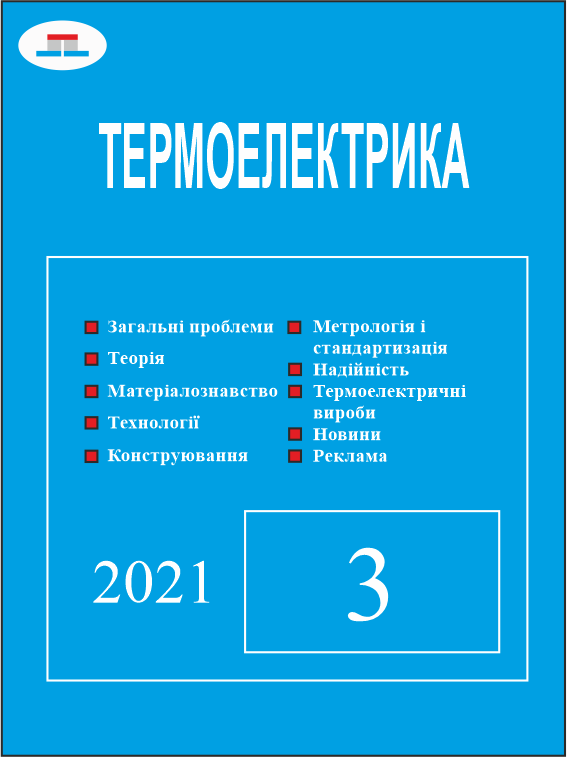Вплив електричних та теплових опорів контактів і комутацій на холодильний коефіцієнт термоелектричного модуля
Ключові слова:
термоелектричний охолодний модуль, холодильний коефіцієнт, електричний контактний опір, тепловий опір комутаційної та ізоляційної пластинАнотація
В роботі описаний метод розрахунку максимального холодильного коефіцієнта для реальної моделі термоелектричного модуля, яка враховує вплив електричного опору контактів та комутацій і теплового опору комутаційних та ізоляційних пластин. Розраховані залежності максимального холодильного коефіцієнта модуля від висоти його віток і перепаду температур. Проведено порівняльний аналіз холодильного коефіцієнта реальної моделі модуля з його “ідеальним” значенням, яке не враховує вплив електричних і теплових опорів контактів, комутаційних та ізоляційних пластин. Бібл. 35, рис. 4, табл. 2.
Посилання
Anatychuk L.I., Vikhor L.M. (2013). The boundaries of thermoelectric cooling for photodetectors.
J.Thermoelectricity, 5, 58–63.
Vainer A.L., Moiseev V.F. (2000). Sovmeshchennyie pribory kriotermoelektricheskoi elektroniki [Combined devices of cryothermoelectric electronics]. Odessa: Negotsiant studio [in Russian].
Mansour K., Qiu Y., Hill C.J., Soibel A., Yang R.Q. (2006). Mid-infrared interband cascade lasers at thermoelectric cooler temperatures. Electron. Lett. 42 (18), 1034-1036.
Chein Reiyu, Huang Guanming (2004). Thermoelectric cooler application in electronic cooling, Appl. Therm. Eng., 24, 2207-2217.
Zhou Yuanyuan, Yu Jianlin (2012). Design optimization of thermoelectric cooling systems for applications in electronic devices. Int. J. Refrig. 35,1139-1144.
Zhang H.Y., Mui Y.C., Tarin M. (2010). Analysis of thermoelectric cooler performance for high power electronic packages. Appl. Therm. Eng. 30, 561-568.
Phelan Patrick E., Chiriac Victor A., Tom Lee Tien-Yu (2002). Current and future miniature refrigeration cooling technologies for high power microelectronics. IEEE Trans. Compon. Packag. Technol. 25 (3).
Huang Hsiang-Sheng, Weng Ying-Che, Chang Yu-Wei, Chen Sih-Li, Ke Ming-Tsun (2010). Thermoelectric water-cooling device applied to electronic equipment. Int. Commun. Heat Mass Transf. 37,140-146.
Chang Yu-Wei, Chang Chih-Chung, Ke Ming-Tsun, Chen Sih-Li (2009). Thermoelectric air-cooling module for electronic devices. Appl. Therm. Eng. 29, 2731-2737.
Zhu Liu, Tan Hongbo, Yu Jianlin (2013). Analysis on optimal heat exchanger size of thermoelectric cooler for electronic cooling applications. Energy Convers. Manage. 76, 685-690.
Li Junhui, Ma Bangke, Wang Ruishan, Han Lei (2011). Study on a cooling system based on thermoelectric cooler for thermal management of high-power LEDs. Microelectron. Reliab. 51,
-2215.
Jou Rong-Yuan (2013). Heat transfer enhancement of the liquid-cooled LED illumination module. Appl. Mech. Mater. 284-287,768-772.
Anatychuk L.I., Kobylyansky R.R. (2012). Thermoelectric device for treatment of radiculitis and spinal massage. AIP Conf. Proc.509–511.
Anatychuk L., Vikhor L., Kotsur M., Kobylianskyi R., Kadeniuk T. (2018). Optimal control of time dependence of temperature in thermoelectric devices for medical purposes. Int. J. Thermophys. 39, 1–12.
Anatychuk L.I., Pasechnikova N.V., Naumenko V.O., Zadorozhnyi O.S., Nazaretyan R.E., Havryliuk M.V., Tiumentsev V.A., Kobylianskyi R.R. (2020). Thermoelectric device for non-contact cooling of human eyes. J.Thermoelectricity, 4, 77-90.
He R.R., Zhong H.Y., Cai Y., Liu D., Zhao F.Y. (2017). Theoretical and experimental investigations of thermoelectric refrigeration box used for medical service. Procedia Eng., 205, 1215–1222.
Güler N.F., Ahiska R. (2002). Design and testing of a microprocessor-controlled portable thermoelectric medical cooling kit. Appl. Therm. Eng., 22 (11), 1271–1276.
Putra Nandy, et al. (2010). The characterization of a cascade thermoelectric cooler in a cryosurgery device. Cryogenics 50, 759-764.
Gillott Mark, Jiang Liben, Riffat Saffa (2009). An investigation of thermoelectric cooling devices for small-scale space conditioning applications in buildings. Int. J. Energy Res.
Cheng Tsung-Chieh, Cheng Chin-Hsiang, Huang Zhu-Zing, Liao Guo-Chun (2011). Development of an energy-saving module via combination of solar cells and thermoelectric coolers for green building applications. Energy, 36.
Shen Limei, Xiao Fuo, Chen Huanxin, Wang Shengwei (2013). Investigation of a novel thermoelectricradiant air-conditioning system. Energy Build. 59, 123-132.
Astrain D., Vian J.G., Albizua J. (2005). Computational model for refrigerators based on Peltier effect application. Appl. Therm. Eng. 25, 3149-3162.
Min Gao, Rowe D.M. (2006). Experimental evaluation of prototype thermoelectric domestic-refrigerators, Appl. Energy 83, 133-152.
Sabah A. Abdul-Wahab, et al. (2009). Design and experimental investigation of portable solar thermoelectric refrigerator. Renew. Energy, 34, 30-34.
Astrain D., Vian J.G., Dominguez M. (2003). Increase of COP in the thermoelectric refrigeration by the optimization of heat dissipation. Appl. Therm. Eng. 23, 2183-2200.
Choi Hyeung-Sik,Yun Sangkook, Whang Kwang-il. Development of a temperature-controlled car-seat system utilizing thermoelectric device. Appl. Therm. Eng. 27, 2841-2849.
Anatychuk L.I., Prybyla A.V., Kibak A.M. (2020). Thermoelectric air conditioners for vehicle seats. J.Thermoelectricity, 4, 90-104.
Miranda A.G., Chen T.S., Hong C.W. (2013). Feasibility study of a green energy powered thermoelectric chip based air conditioner for electric vehicles. Energy 59,633-641.
Riffat S.B., Ma Xiaoli (2004). Improving the coefficient of performance of thermoelectric cooling systems: a review. Int. J. Energy Res. 28, 753–768.
Zhao D., Tan G. (2014). A review of thermoelectric cooling: Materials, modeling and applications. Appl. Therm. Eng. 66, 15-24.
Min Gao, Rowe D.M. (2000). Improved model for calculating the coefficient of performance of a Peltier module. Energy Convers. Manage. 41,163-171.
Xuan X.C. (2003). Investigation of thermal contact effect on thermoelectric coolers. Energy Convers. Manage. 44,399–410.
Anatychuk L.I. (2003). Termoelektrichestvo. T.II. Termoelektricheskiie preobrazovateli energii [Thermoelectricity. Vol.II. Thermoelectric power converters]. Kyiv, Chernivtsi: Institute of Thermoelectricity [in Russian].
Taylor P.J., Maddux J.R., Meissner G., Venkatasubramanian R. et al. (2013). Controlled improvement in specific contact resistivity for thermoelectric materials by ion implantation. Appl. Phys. Lett. 103, 043902 (1-5).
Vikhor L.M., Anatychuk L.I., Gorskyi P.V. (2019). Electrical resistance of metal contact to Bi2Te3 based thermoelectric legs. J. Appl. Phys. 126, 164503.


